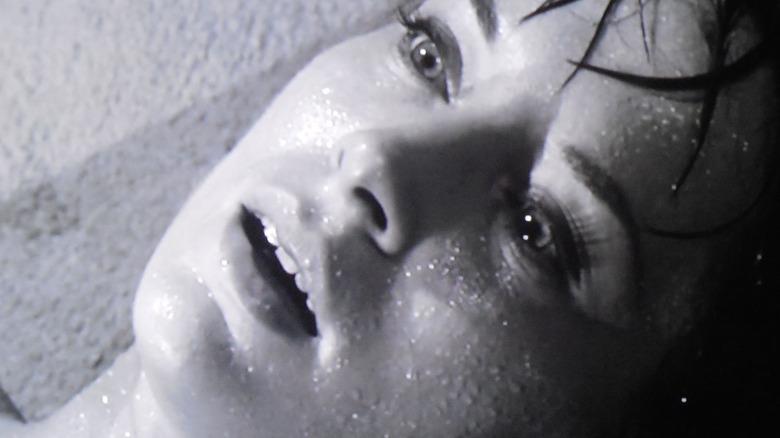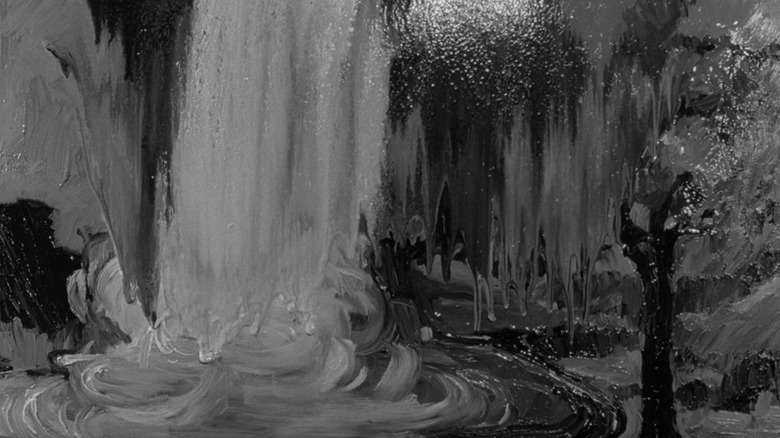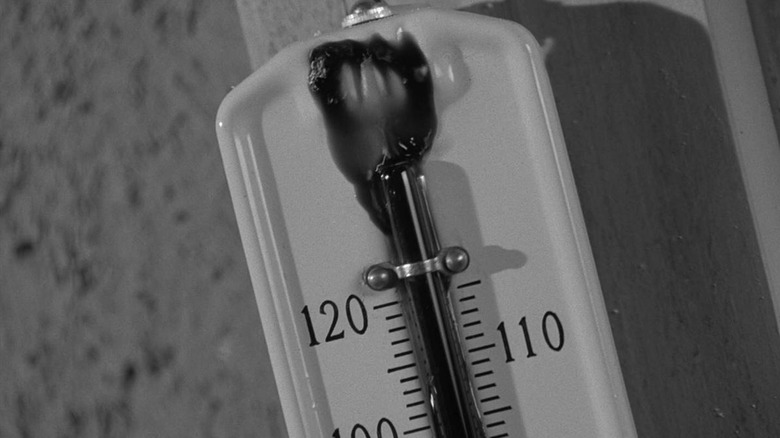The Twilight Zone Used Some Brilliantly Cheap Special Effects To Set The World On Fire
The "Twilight Zone" episode "The Midnight Sun" (November 17, 1961) took place on an Earth that had fallen out of its orbit and was drifting very slowly closer and closer toward the sun. The episode was an exploration of humanity during its waning hours, as seen through the eyes of Norma (Lois Nettleton), a painter who tried desperately to hang on to water and stay cool as temperatures rose and rose. Norma's only recourse is to paint the fires she sees out the window and the burning, growing sun in the sky. Eventually, her neighbor breaks down and implores Norma to paint something cool and refreshing, like a waterfall. The episode ends with Norma being overwhelmed by the heat and her neighbor dying of heat stroke.
There is a twist, of course. Norma wakes up in bed, having dreamed the entire episode. It's revealed that the Earth is, in fact, drifting away from the sun and that temperatures have been slowly dropping below freezing. Norma recalls her dream of dying in the heat and now finds it to be very, very pleasant here in the cold.
"The Midnight Sun," from a filmmaking perspective, had a lot of ground to cover. The episode's writer (Rod Serling) and director (Anton Leader) had to depict an entire world burning up and losing touch with reality but had to achieve it with only a few days to shoot and a paltry budget of $52,577. In Marc Scott Zicree's invaluable book "The Twilight Zone Companion," Leader recalled some of the low-budget ways he and his crew depicted extreme heat in a pinch. It seems it was a clever use of makeup, wax, and actual heaters.
The melting canvas
"With a very limited budget and facilities, we had to do a lot of improvising," Leader explained. "[...] We had to use every means available to us to project the fear of this developing heat and this cataclysmic ending to the world. I think we did a pretty good job."
One of the climactic moments of "Midnight Sun" was when Norma's painting of the waterfall also succumbed to the heat. As the temperature rose, the paint began to melt off the canvas, warping the image. According to Zicree's book, this effect was achieved merely by painting on a hot plate with wax. They turned the hot plate on, and the painting melted right off. Leader also employed time-old makeup conceits to make the actors look like they were sweating. No, Lois Nettleton was not being constantly sprayed down. It's more likely the makeup artists daubed her head with witch hazel to form sweat-like droplets.
It helped that TV sets were generally hot back in 1961. There weren't advanced air conditioning systems yet and one couldn't run noisy fans while the microphones were on. As such, the actors were generally pretty toasty under the best of conditions. Leader thought that he could evoke the right mood, however, if he carried in some heaters and made the set just that much warmer for everyone. That wasn't done to achieve any particular look, mind you, but was only meant to change the mood on the set.
Leader admitted, though, that he didn't want to go too far with it, as after a while, the heat would just make people grumpy.
Hot, but not too hot
Leader continued:
"In those days, they had no air conditioning on the set and we shot in summer, so it was hot enough to give you the initial feeling. I remember that there were a couple of scenes in which I asked the electrical grip to add heat, not so much heat that it would show on the film, but heat that we would feel on the set. It made us distinctly uncomfortable, but I think it helped us develop the feeling that we had of heat."
Leader had his limits, though, saying that he "didn't do that throughout, because its effect would have been lost eventually." He added, "We would have just been plain simply miserable and angry with each other for being involved in this thing."
The twist ending was entirely Serling's idea. It seems that being overwhelmed by heat would indeed be a common fantasy for someone who is slowly freezing to death. The cold effects were much easier to achieve, it appears. There was only snow and some frost on the window. And a lot of coats.
Before "The Midnight Sun," Leader had already directed the "Twilight Zone" episode "Long Live Walter Jameson," an episode about a man who was granted seeming immortality 2,000 years earlier. Both "Jameson" and "The Midnight Sun" are excellent episodes of the series. Leader moved throughout the television world for decades, directing episodes of "Gilligan's Island," "Rawhide," "Ironside," "Star Trek," "I Spy," "Get Smart," and many others. He passed away in 1988 at the age of 74.


